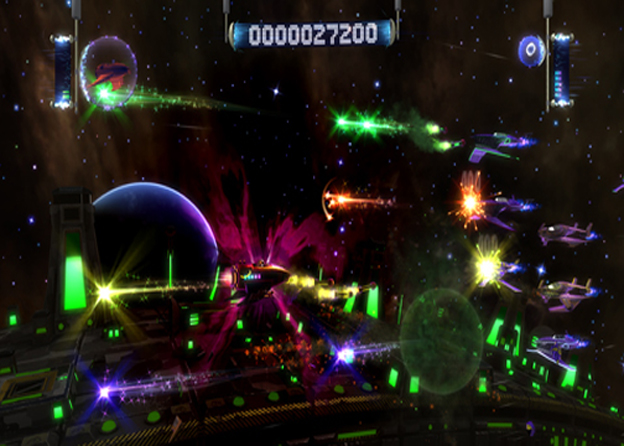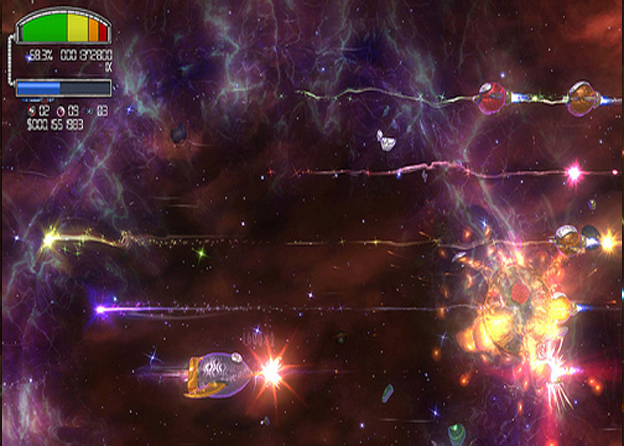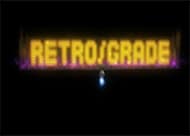Not Enough Of A Great Idea
There isn’t a whole lot of innovation in the rhythm game market. This is mostly because there is only so much you can do to innovate on a concept as simple as “press the button to the beat.” That’s not to say that certain games aren’t trying though. For example, Retro/Grade, a new game by 24 Caret Games, combines the rhythm genre with space shooters and an interesting time-warping mechanic. To an extent, Retro/Grade really does breathe new life into the tired old rhythm game genre. However, it does so with novelty, and when this novelty wears off, you simply find yourself pressing buttons to the beat again.
When the game starts, you aren’t actually playing a rhythm game at all. Instead, It puts you in control of a fighter ship at the end of an epic space shooter. You fire your lasers at the gigantic final boss, and as it explodes into pieces, the end credits roll. Then halfway through the credits a hole opens up in space time and the universe is destroyed.

That’s when the game actually starts. After this universal destruction, time starts flowing backward, past the credits, and past the final boss. You get to see the lasers you fired getting sucked back into your ship and the final boss pick itself up and put itself back together. You’ve been granted a second chance at life and must now save the universe by undoing your epic space shooter journey exactly as it happened .
Every stage in this game takes place on a backward trip through time. You fly backward from the end of a level to the start. All the while, the lasers you fired are moving backward from the right side of the screen to the left, essentially rewinding toward your ship. It’s your job to line your ship up with them and press the X button at the exact time they hit your ship’s nose. Essentially, you are re-enacting the initial firing of the lasers, just in reverse. If a laser rewinds and you aren’t there to fire it, you create a time paradox which harms the timestream. Damage the timestream enough and the universe collapses in on itself.

Luckily, you must have been listening to some pretty awesome tunes as you blasted your way through an evil space empire, as every single laser blast in the game follows the beat of the background music of the stage. So, as you would expect, this eventually just becomes another rhythm game experience. You move up and down the different note/laser streams, and simply tap X whenever they hit your ship. At times, you will also collect reverse power-ups like a spread shot or a rapid laser. These “power-ups” just cause you to tap the X button to a different rhythm. Spread shots need to be tapped rapidly while long laser fire needs to be held down. They aren’t really “power-ups” at all, just a different coat of paint on beat changes.
The real power-ups of the game either multiply your score or let you go into a “star power” type mode (which also multiplies your score). However, your score is actually counting down toward zero, which is a neat little touch. You also get “tetro fuel,” which allows you to rewind the already rewound time, essentially moving it forward. This allows you to fix up mistakes and lost beats as you do your best Prince of Persia impression. Even if you eventually fail a stage, you can still rewind back from the game-over screen, a feature that music games have needed for a while.

There is an extra dimension to Retro/Grade beyond simply tapping a button to the beat of the music. Enemy lasers will travel from the left side of the screen to their enemies of origin. Apparently, you actually managed to score a perfect run in this space shooter and never managed to let an enemy laser hit you. As such, you need to avoid all of these lasers as you rewind through time while still managing to hit every beat. It’s a strange dodging game that almost feels like a more hectic version of Audiosurf.
There are ten different levels in the game, each with their own techno-inspired background track. Each of these levels comes in several different difficulties. Beginner mode presents only two-note streams with rare beats and enemy lasers, while harder difficulties add more and more note streams with incredibly hectic patterns to keep track of. There are also a number of challenges to undertake and leaderboards to climb your way to the top of, but the overall gameplay experience is actually rather short. You can beat all ten levels in a little under an hour, and since the game starts you on beginner mode without even really asking you if you want to change difficulties, you will probably blow through that first.
Here lies the biggest issue. The game is far too short. The music in the game never changes or gets longer at higher difficulties. There are, essentially, only ten tracks to play throughout the whole game. Not to mention, many of these tracks simply crawl along. I’m a fan of techno music, but this isn’t the hard thumbing club beats that you would expect from a rhythm game like this one. Rather, they are all kind of slow mechanical rhythms that would be better situated for a late night chill session rather than a space shooter. Frankly, I just didn’t feel like listening to them all again to conquer the levels at a higher difficulty.

The cool thing about Retro/Grade is that you can play it with your existing Rock Band or Guitar Hero guitars. To be fair, it’s way cooler to control time and space with rock and roll than it is to control time and space with a controller. However, even this starts to become dull after you’ve run through the game once or twice. The music simply isn’t good enough to warrant coming back and playing the levels over again. Maybe if the game had more tracks, it would have more replay value, but as it stands I was done with this game shortly after I started it.
That’s not to say that the game is bad. In fact, it’s a pretty cool idea that is executed well. The reverse boss battles in particular were some of the coolest moments the game had to offer. The ability to rewind past your mistakes makes the game a lot of fun for perfectionists like me. For the time that I played it, Retro/Grade was very enjoyable.
The problem is that I didn’t play it for that long. Ten tracks just isn’t enough to carry a rhythm game, even an eight-dollar one. The replay value is just so depressingly low. I’d almost say you should get Retro/Grade in the hopes that your eight-dollar contribution will allow 24 Caret to make a sequel that is far more fleshed out. As it stands, Retro/Grade is a well-implemented fun new rhythm game concept that gets repetitive far too quickly.
RATING OUT OF 5 RATING DESCRIPTION 3.5 Graphics
The graphics are kind of basic, but the boss battles are impressive. 4.3 Control
Controlling the game with a guitar is probably the best part. 3.8 Music / Sound FX / Voice Acting
Maybe I’m crazy, but I just couldn’t get into the techno soundtrack. 2.0 Play Value
Unfortunately, ten tracks do not carry a whole music game. 3.7 Overall Rating – Good
Not an average. See Rating legend below for a final score breakdown.
| Review Rating Legend | |||
|---|---|---|---|
| 0.1 – 1.9 = Avoid | 2.5 – 2.9 = Average | 3.5 – 3.9 = Good | 4.5 – 4.9 = Must Buy |
| 2.0 – 2.4 = Poor | 3.0 – 3.4 = Fair | 4.0 – 4.4 = Great | 5.0 = The Best |
Game Features:
